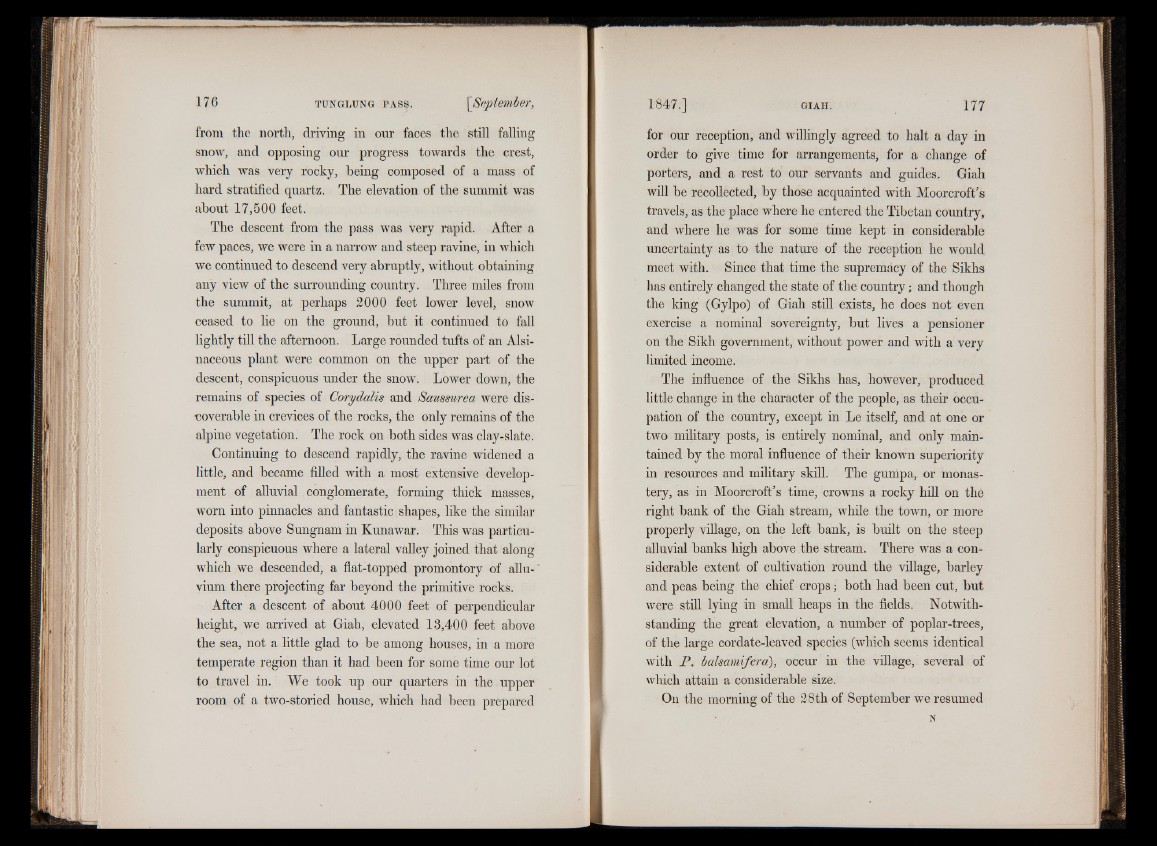
from the north, driving in our faces the still falling
snow, and opposing our progress towards the crest,
which was very rocky, being composed of a mass of
hard stratified quartz. The elevation of the summit was
about 17,500 feet.
The descent from the pass was very rapid. After a
few paces, we were in a narrow and steep ravine, in which
we continued to descend very abruptly, without obtaining
any view of the surrounding country. Three miles from
the summit, at perhaps 2000 feet lower level, snow
ceased to lie on the ground, but it continued to fall
lightly till the afternoon. Large rounded tufts of an Alsi-
naceous plant were common on the upper part of the
descent, conspicuous under the snow. Lower down, the
remains of species of Corydalis and Saussurea were discoverable
in crevices of the rocks, the only remains of the
alpine vegetation. The rock on both sides was clay-slate.
Continuing to descend rapidly, the ravine widened a
little, and became filled with a most extensive development
of alluvial conglomerate, forming thick masses,
worn into pinnacles and fantastic shapes, like the similar
deposits above Sungnam in Kunawar. This was particularly
conspicuous where a lateral valley joined that along
which we descended, a flat-topped promontory of allu-'
vium there projecting far beyond the primitive rocks.
After a descent of about 4000 feet of perpendicular
height, we arrived at Giah, elevated 13,400 feet above
the sea, not a little glad to be among houses, in a more
temperate region than it had been for some time our lot
to travel in. We took up our quarters in the upper
room of a two-storied house, which had been prepared
for our reception, and willingly agreed to halt a day in
order to give time for arrangements, for a change of
porters, and a rest to our servants and guides. Giah
will be recollected, by those acquainted with Moorcroft s
travels, as the place where he entered the Tibetan country,
and where he was for some time kept in considerable
uncertainty as to the nature of the reception he would
meet with. Since that time the supremacy of the Sikhs
has entirely changed the state of the country% and though
the king (Gylpo) of Giah still exists, he does not even
exercise a nominal sovereignty, but lives a pensioner
on the Sikh government, without power and with a very
limited income.
The influence of the Sikhs has, however, produced
little change in the character of the people, as their occupation
of the country, except in Le itself, and at one or
two military posts, is entirely nominal, and only maintained
by the moral influence of their known superiority
in resources and military skill. The gumpa, or monastery,
as in Moorcroft’s time, crowns a rocky hill on the
right bank of the Giah stream, while the town, or more
properly village, on the left bank, is built on the steep
alluvial banks high above the stream. There was a considerable
extent of cultivation round the village, barley
and peas being the chief crops; both had been cut, but
were still lying in small heaps in the fields. Notwithstanding
the great elevation, a number of poplar-trees,
of the large cordate-leaved species (which seems identical
with P. balsamifera), occur in the village, several of
which attain a considerable size.
On the morning of the 28th of September we resumed
N